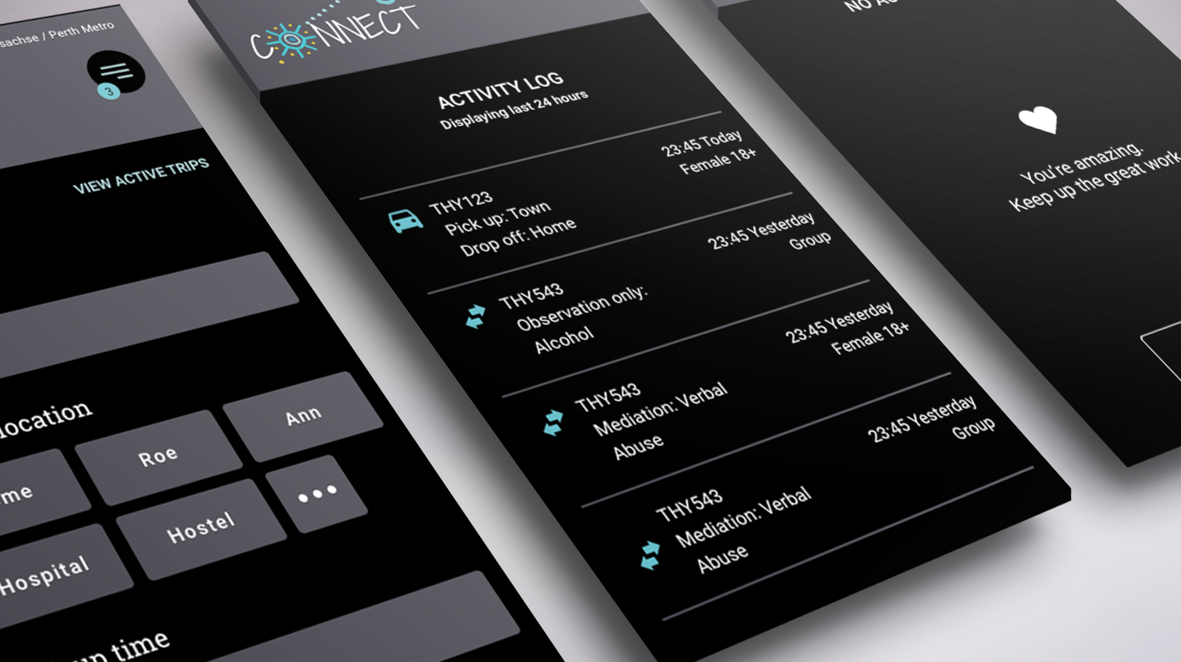Enhancing Data Collection for the Connector Program
This case study showcases the successful development and implementation of a PWA for the DOC’s Connector Program, highlighting the process, challenges, solutions, and positive outcomes achieved.
Opportunity
The Department of Communities (DOC) recognized the need to improve data collection and reporting for their Connector Program. To address this, a comprehensive Product Discovery was conducted to validate existing understandings and identify the Most Valuable Product (MVP). The goal was to quickly build a product that would streamline data collection and facilitate real-world changes to the Connector Program.
Solution
The solution was to develop a Responsive Progressive Web Application (PWA) to collect data on support, transport, mediation, prevention, and follow-up information from mobile devices. This data would then be pushed daily to the DOC’s Data Lake. The product was delivered within seven weeks and involved several key stages:
Framing
Understand who the DOC aimed to be and identify current opportunities and pain points.
Product Strategy
Validation: Met with potential users to confirm pain points and opportunities.
Solution Identification: Proposed solutions for all identified opportunities.
MVP Design: Designed and tested a high-impact, low-effort initial product.
Dual Track Delivery
Iterative Development: Built the product iteratively, ensuring alignment with stakeholder and user needs through regular check-ins.
Measurement
Monitoring and Adjustment: Monitored the product post-launch and made iterative adjustments until all users were satisfied.
Outcome
The new product yielded several significant benefits:
Instant Data: Reports that previously took up to six months from third-party vendors are now received daily.
Time Savings: Reduced paperwork and data entry for Connectors, Office Administrators, and Managers, allowing them to provide more community support.
Data Consistency: Uniform data format from all vendors increased reliability and comparability.
Better Insights: Connected data points provide deeper insights and tell a coherent story.
Strong Foundation: The customisable product was repurposed by other DOC areas for their data collection needs.
Ease of Use: Lightweight and user-friendly, suitable for use in various environments.
Security: Enhanced data capture security compared to previous methods.
Conclusion
Working on this project was incredibly fulfilling for me, as it allowed me to contribute to the community and streamline inefficient processes—two things I am passionate about. Since building the app, the Department of Communities has secured additional funding to extend the Connector Program to other locations. This success is a testament to the excellent support the program provides and the real-time impact demonstrated through the up-to-date and accurate data we have been able to capture. The ability to prove the program's effectiveness with reliable data underscores the value of this project and its positive influence on the community.
Personas
Activity Examples
Why a Responsive PWA?
A Responsive PWA was chosen due to its reduced build time, offline capabilities, and ease of maintenance. It was suitable for both Metro Connectors (preferring mobile solutions for on-foot tasks) and Regional Connectors (preferring tablets for in-vehicle use). The responsive design allowed the product to meet diverse area requirements, and its lightweight nature minimized risks related to theft or injury. The product's design also enabled a smooth handover to the client's IT department for ongoing maintenance.
Design Challenges
-
Problem Statement: The services provided by the Connector Program vary significantly between Metro and Regional areas, necessitating a flexible and adaptable data collection solution to meet the distinct needs of each location.
Solution: Created a customizable product with an admin console that allows Managers to adjust features based on specific needs.
-
Problem Statement: The previous data collection method was cumbersome, leading to low usage and incomplete data entry by Connectors. There was a need for a more user-friendly system to ensure higher engagement and accurate data capture.
Solution: Simplified data entry with pre-filled buttons, increasing ease of use and encouraging adoption. Monitored usage confirmed higher engagement levels.
-
Problem Statement: Capturing personal data without explicit consent is illegal, requiring a solution that protects client privacy while still enabling effective data collection and analysis.
Solution: Ensured data fields were high-level to protect privacy, using interaction IDs instead of personal details.
-
Problem Statement: Variations in paper-based forms across different areas led to inconsistent data, making it difficult to compare and analyse information uniformly across the Connector Program.
Solution: Standardised paper-based forms across different areas through negotiation and stakeholder management.
-
Problem Statement: The existing documentation focused primarily on negative data, overlooking the positive changes and impacts achieved by the program. There was a need to update the forms to capture a more comprehensive view of the program's effectiveness.
Solution: Updated forms to allow recording of positive changes and impacts, not just negative data.
-
Problem Statement: Inconsistent connectivity in some Regional areas hinders real-time data entry, necessitating a solution that allows Connectors to collect and store data offline and sync it when connectivity is restored.
Solution: Implemented an offline mode for data entry in areas with connectivity issues, with automatic syncing once coverage is available.
Contextual Enquiry
One of the highlights of the project was the opportunity to shadow the Connectors both in the Metro and Regional areas. For the Metro area, our lead engineer Tonnes joined us. We were able to see firsthand the challenges Connectors faced and understand why they needed a lightweight and easy-to-use solution. This experience provided invaluable insights into their daily routines and pain points.
For the Regional areas, I conducted the shadowing alone. When I returned, I had the office recreate the situation to provide context for the team. This immersive experience allowed the team to grasp the unique challenges faced by Regional Connectors. In UX terms, this approach is known as contextual enquiry. This method enabled us to deeply understand both the Connectors' and Clients’ needs and build a solution that truly addressed their challenges. It also helped us develop empathy for the users, ensuring that the solution was user-centred and effectively met their needs.








